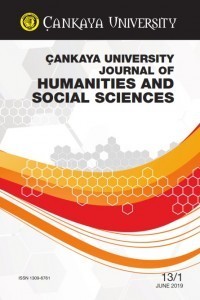Öz
Hanif Kureishi’s 2014 novel, The Last Word is a “roman à clef,” which presents the literary biography of a world-renowned author of post-colonial literature -V.S. Naipaul- under the pseudonym of Mamoon Azam. This article traces the path of Kureishi, who assumes the role of the modern biographer as an artist engaged in the creative process, rather than an objective historian recording facts about an individual’s life. In the novel, it is observed that Kureishi meticulously avoids being a mere chronicler of events that shape his subject’s literary and private life; instead, Kureishi’s intention is to project a truthful personality portrait of “a literary giant,” that is, Mamoon Azam, the fictional counterpart of the factual V.S. Naipaul. Thus, the article particularly investigates such issues as Kureishi’s preferred structural methods in treating his biography as a work of art rather than a dry, barely readable, informative account of a life story; the possible difficulties a modern life-writer may encounter; and the changing role of the modern biographer from craftsman to artist. A final discussion in the article is based on Kureishi’s liminal status as a representative of the so-called ethnic authors living and producing in the West.
Anahtar Kelimeler
Kaynakça
- Backscheider, Paula R. Reflections on biography. Oxford University Press, 1999.
- Bhabha, Homi. The Location of Culture. Routledge, 1994.
- Bowen, Catherine D. Biography: The craft and the calling. Little, Brown, 1968.
- Clifford, James, ed. Biography as an Art. Oxford University Press, 1962.
- French, Patrick. The World is What It is: The Authorized Biography of V.S. Naipaul. CPI Mackays, 2008.
- Harmon, William and Holman, C. Hugh, eds. A Handbook to Literature. Prentice Hall, 1996.
- Kureishi, Hanif. The Last Word. Faber and Faber, 2014.
- ---. “The Last Word.” Interview by Razia Iqbal. Asia House Bagri Foundation Literature Festival 2014, https://www.youtube.com/watch?v=v1R8oq_QZAY& feature=youtu.be. Accessed 12 April 2020.
- Marcus, Laura. “Life Writing.” The Edinburgh Introduction to Studying English Literature, 2014, pp.148-157. https://www.jstor.org/stable/10.3366/ j.ctt1g09vqj.18. Accessed 30 July 2019.
- Massie, Robert K. “Narrating the Past: History or Biography.” Biography and Source Studies, edited by Frederick R. Karl. AMS Press, 1994. pp.103-115.
- Oakley, Ann. “The Social Science of Biographical Life-Writing: Some Methodological and Ethical Issues.” International Journal of Social Research Methodology, vol. 13, no. 5, 2010, pp.425-39. https://doi.org/10.1080/13645571003593583. Accessed 10 July 2019.
- O’Connor, Ulick. Biographers and the Art of Biography. Quartet Books, 1993.
- Weber, Donald. “No Secrets Were Safe from Me: Situating Hanif Kureishi.” The Massachusetts Review, vol. 38, no. 1, 1997, pp. 119-35.
- https://www.jstor.org/stable/25090863. Accessed 27 March 2020.
Öz
Hanif Kureishi’s 2014 novel, The Last Word is a “roman à clef,” which presents the literary biography of a world-renowned author of post-colonial literature -V.S. Naipaul- under the pseudonym of Mamoon Azam. This article traces the path of Kureishi, who assumes the role of the modern biographer as an artist engaged in the creative process, rather than an objective historian recording facts about an individual’s life. In the novel, it is observed that Kureishi meticulously avoids being a mere chronicler of events that shape his subject’s literary and private life; instead, Kureishi’s intention is to project a truthful personality portrait of “a literary giant,” that is, Mamoon Azam, the fictional counterpart of the factual V.S. Naipaul. Thus, the article particularly investigates such issues as Kureishi’s preferred structural methods in treating his biography as a work of art rather than a dry, barely readable, informative account of a life story; the possible difficulties a modern life-writer may encounter; and the changing role of the modern biographer from craftsman to artist. A final discussion in the article is based on Kureishi’s liminal status as a representative of the so-called ethnic authors living and producing in the West.
Kaynakça
- Backscheider, Paula R. Reflections on biography. Oxford University Press, 1999.
- Bhabha, Homi. The Location of Culture. Routledge, 1994.
- Bowen, Catherine D. Biography: The craft and the calling. Little, Brown, 1968.
- Clifford, James, ed. Biography as an Art. Oxford University Press, 1962.
- French, Patrick. The World is What It is: The Authorized Biography of V.S. Naipaul. CPI Mackays, 2008.
- Harmon, William and Holman, C. Hugh, eds. A Handbook to Literature. Prentice Hall, 1996.
- Kureishi, Hanif. The Last Word. Faber and Faber, 2014.
- ---. “The Last Word.” Interview by Razia Iqbal. Asia House Bagri Foundation Literature Festival 2014, https://www.youtube.com/watch?v=v1R8oq_QZAY& feature=youtu.be. Accessed 12 April 2020.
- Marcus, Laura. “Life Writing.” The Edinburgh Introduction to Studying English Literature, 2014, pp.148-157. https://www.jstor.org/stable/10.3366/ j.ctt1g09vqj.18. Accessed 30 July 2019.
- Massie, Robert K. “Narrating the Past: History or Biography.” Biography and Source Studies, edited by Frederick R. Karl. AMS Press, 1994. pp.103-115.
- Oakley, Ann. “The Social Science of Biographical Life-Writing: Some Methodological and Ethical Issues.” International Journal of Social Research Methodology, vol. 13, no. 5, 2010, pp.425-39. https://doi.org/10.1080/13645571003593583. Accessed 10 July 2019.
- O’Connor, Ulick. Biographers and the Art of Biography. Quartet Books, 1993.
- Weber, Donald. “No Secrets Were Safe from Me: Situating Hanif Kureishi.” The Massachusetts Review, vol. 38, no. 1, 1997, pp. 119-35.
- https://www.jstor.org/stable/25090863. Accessed 27 March 2020.
Ayrıntılar
| Birincil Dil | İngilizce |
|---|---|
| Konular | Edebi Çalışmalar |
| Bölüm | Makaleler |
| Yazarlar | |
| Yayımlanma Tarihi | 25 Haziran 2020 |
| Yayımlandığı Sayı | Yıl 2020 Cilt: 14 Sayı: 1 |
Çankaya University Journal of Humanities and Social Sciences
General Manager | Genel Yayın Yönetmeni, Öğretmenler Caddesi No.14, 06530, Balgat, Ankara.
Communication | İletişim: e-mail: mkirca@gmail.com | mkirca@cankaya.edu.tr
https://cujhss.cankaya.edu.tr/
CUJHSS, eISSN 3062-0112


